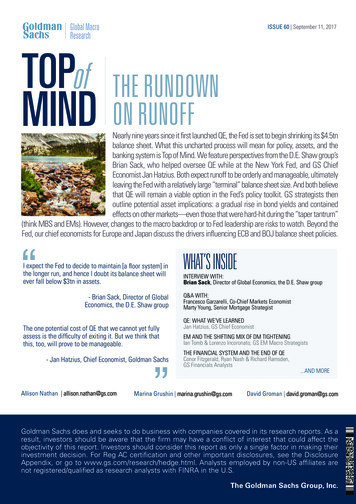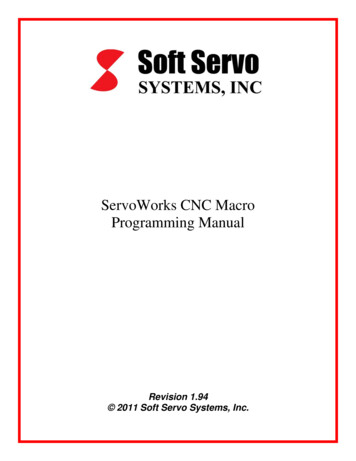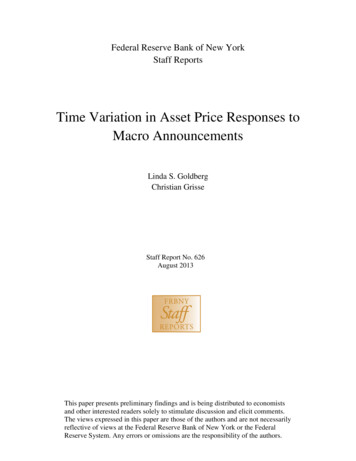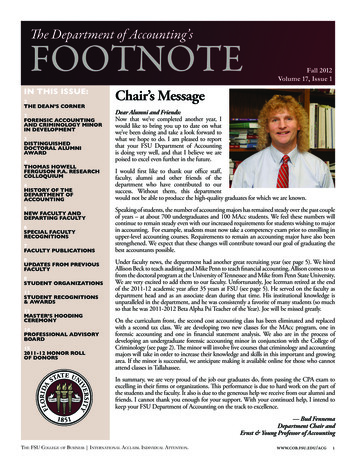
Transcription
Note: The following is a redacted version of the original report published May 21, 2021 [41 �Global MacroResearch’’’ISSUE 98 May 21, 2021 6:00 PM EDT’TOPofMINDCRYPTO: A NEW ASSET CLASS?With cryptocurrency prices remaining extremely volatile even as interest in cryptosfrom credible investors has been rising, and legacy financial institutions—includingourselves—have been launching new crypto products and services, crypto isundoubtedly Top of Mind. Amid the recent volatility, we ask experts whether cryptoscan and should be considered an institutional asset class, including Galaxy’sMichael Novogratz (Yes; the mere fact that a critical mass of credible investors isengaging with cryptos has cemented this), NYU’s Nouriel Roubini (No; cryptos haveno income, utility or relationship with economic fundamentals), Grayscale’s MichaelSonnenshein (Yes; their strong rebound in 2020 reassured investors about theirresiliency as an asset class), and GS’s own Mathew McDermott (clients increasingly say “yes”). And GS researchanalysts also weigh in. We then speak to former SEC advisor Alan Cohen, Trail of Bits’ Dan Guido, and Chainalysis’Michael Gronager to explore the regulatory, technological, and security obstacles to further institutional adoption.“We’ve now hit a critical mass of institutionalengagement [in crypto]. Everyone from the major banksto PayPal and Square is getting more involved, which is aloud and clear signal that crypto is now an official assetclass.- Michael NovogratzBitcoin and other cryptocurrencies aren’t assets. Assetshave some cash flow or utility that can be used todetermine their fundamental value. Bitcoin and othercryptocurrencies have no income or utility.- Nouriel RoubiniI have yet to find somebody who has really done theirhomework on crypto assets that isn’t truly amazed by thepotential for the asset class.- Michael SonnensheinWHAT’S INSIDEINTERVIEWS WITH:Michael Novogratz, Co-founder and CEO, Galaxy Digital HoldingsNouriel Roubini, Professor of Economics, New York University SternSchool of BusinessMichael Sonnenshein, CEO, Grayscale InvestmentsMathew McDermott, Global Head of Digital Assets, Goldman SachsAlan Cohen, former Senior Policy Advisor, US Securities andExchange CommissionDan Guido, Co-founder and CEO, Trail of BitsMichael Gronager, Co-founder and CEO, ChainalysisBITCOIN AS A MACRO ASSETZach Pandl, GS Markets ResearchCRYPTO IS ITS OWN CLASS OF ASSETJeff Currie, GS Commodities ResearchWHAT IS A DIGITAL STORE OF VALUE?Mikhail Sprogis and Jeff Currie, GS Commodities ResearchTHE ROLE OF CRYPTO IN BALANCED PORTFOLIOSChristian Mueller-Glissmann, GS Multi-Asset Strategy Research.AND MORE“Allison Nathan allison.nathan@gs.com Gabriel Lipton Galbraith gabe.liptongalbraith@gs.com Jenny Grimberg jenny.grimberg@gs.comInvestors should consider this report as only a single factor in making their investment decision. ForReg AC certification and other important disclosures, see the Disclosure Appendix, or go towww.gs.com/research/hedge.html.The Goldman Sachs Group, Inc.
Top of MindIssue 98Macro news and viewsElWe provide a brief snapshot on the most important economies for the global marketsUSJapanLatest GS proprietary datapoints/major changes in viewsLatest GS proprietary datapoints/major changes in views We now expect core PCE inflation to peak at 2.8% in May andfall to 2.25% by year-end 2021 after the strong April CPI print. Unemployment; we expect a somewhat less front-loaded jobsrecovery, but still see unemployment at 4% by year-end 2021. We lowered our 2Q21 and CY21 real GDP growth forecasts to1.8% qoq ann. and 2.6%, respectively, after the imposition of athird state of emergency, and see a more back-loaded recovery.Datapoints/trends we’re focused on Pent-up demand, which should boost spending by 3.1tn(1% of consumption) and 3.9tn (1.3%) in the first andsecond years after reopening, respectively. Fiscal policy; additional support is a possibility. BoJ policy; we expect the status quo in policy to remain for along time with little impact from the inflation outlook.Pandemic distortions to core inflation should peak soonThird state of emergency delays recoveryCore PCE and contributions to its 2020-22 deviation from trendAggregate mobility index, index (1/3-2/6/2020 100)Datapoints/trends we’re focused on Taper timeline; we think the Fed will only start to hint at taperingin 2H21 and begin to taper in early 2022. Fed liftoff; if our taper timeline is right, then liftoff will probablynot be on the table for about two years.3.02.52.0Stimulus-Sensitive and/or Bottlenecked Core GoodsVirus-Sensitive Services and ApparelCombined Impulse on YoY Core PCE InflationCore PCE Inflation (YoY) and GS Forecast100902% Inflation TargetForecast1.5801.0Second stateof ct-21Apr-22First stateof emergencyOct-22Note: Virus-sensitive categories include airfares, hotels, recreation admissions, and ground transport.Stimulus/bottlenecked categories include new cars, used cars, appliances, electronics, recreation vehicles, andmiscellaneous core goods. Trend calculated as the 2015-2019 category average. April 2021 reflects GS nowcastbased on available source data.Source: Department of Commerce, Haver Analytics, Goldman Sachs GIR.Third stateof emergency60Mar-20 May-20 Jul-20Sep-20 Nov-20 Jan-21 Mar-21 May-21Source: Google LLC "Google COVID-19 Community Mobility Reports";https://www.google.com/covid19/mobility/. Accessed: 5/20/21. Goldman Sachs GIR.EuropeEmerging Markets (EM)Latest GS proprietary datapoints/major changes in viewsLatest GS proprietary datapoints/major changes in views We raised our 2021 UK GDP forecast to 8.1% based on upwardrevisions to GDP and stronger growth momentum. Vaccine pace, which has more than doubled since March, puttingthe Euro area on track to vaccinate 50% of the pop. by mid-June. We lowered our Q2 and full-year 2021 India real GDP growthforecasts to -20.5% qoq ann. and 9.7% yoy, respectively.Datapoints/trends we’re focused on Virus growth, which remains high in India and parts of LatAm. China turning point; with the V-shaped recovery complete, thepolicy focus is shifting to long-term stability and growth. Impact of rising US yields, particularly rising real rates, whichremains a key risk for EMs. Rising oil prices; we see Brent crude prices rising to 75/bblover 3m, which should support EM HY oil exporters.Europe still facing much tighter restrictions than USA COVID-19 tidal wave for parts of EMGS Effective Lockdown Index, indexDaily change in confirmed cases (7dma), thousandsDatapoints/trends we’re focused on Euro area lockdowns, which should continue to loosen ahead ofa summer reopening, supporting a growth surge. Tourism season; delaying int’l travel into early August wouldreduce av. growth in Southern Europe by 0.25 pp in Q2/Q3.10090United StatesUnited KingdomSpainGermanyFranceItaly8080Russia (Left)705060350Mainland China (Left)6070400Brazil (Left)South Africa (Left)300India (Right)250504020040301502010010503020100Jan-20 Mar-20 May-20Jul-20Sep-20 Nov-20Jan-21 Mar-21 May-21Source: University of Oxford, "Google COVID-19 Community Mobility Reports";https://www.google.com/covid19/mobility/. Accessed: 5/20/21, Goldman Sachs GIR.Goldman Sachs Global Investment Research0MarMayJulSepNovJanMarMay0Source: JHU, Goldman Sachs GIR.2
Top of MindIssue 98Crypto: a new asset class?ElWith cryptocurrency prices remaining extremely volatile onnews about regulatory crackdowns, environmental concernsand heightened tax scrutiny even as interest in crypto assetsfrom credible investors has been rising and legacy financialinstitutions—including ourselves—have been launching newcrypto offerings, crypto is undoubtedly Top of Mind. We firstwrote about bitcoin in 2014 and cryptos more broadly in 2018,exploring the potential and risks of the crypto ecosystem.Amid the recent volatility, here we focus on whether cryptoassets can be considered an institutional asset class.We start by speaking with Michael Novogratz, Co-founder andCEO of Galaxy Digital Holdings, which is active in cryptoinvesting and trading, asset management, and venturefinancing. He argues that the mere fact that a critical mass ofcredible investors and institutions is now engaging with cryptoassets has cemented their position as an official asset class.And, despite the price volatility, he doesn’t see the institutionalinterest in bitcoin, which he primarily views as a convenientstore of value, waning as long as the current macro and politicalbackdrop—in which the government has no imperative to stopspending on social issues that the Fed is largely financing—continues, and crypto remains in the adoption cycle.Michael Sonnenshein, CEO of Grayscale Investments, theworld’s largest digital asset manager, agrees that institutionalinvestors now generally appreciate that digital assets are hereto stay, with investors increasingly attracted to the finite qualityof assets like bitcoin—which is verifiably scarce—as a way tohedge against inflation and currency debasement, and todiversify their portfolios in the pursuit of higher risk-adjustedreturns. Even though crypto assets have behaved as anythingbut a diversifier over the past year—selling off more thantraditional assets as the COVID-19 pandemic set in—he saysthat their faster and stronger rebound in 2020 only reassuredinvestors about their resiliency as an asset class.But what makes a crypto like bitcoin—which has no income, nopractical uses and high volatility—a good store of value?Novogratz’s answer: because “the world has voted that theybelieve” it is. Zach Pandl, GS Co-Head of Global FX, Rates, andEM Strategy, largely agrees, arguing that bitcoin’s potential forwidespread social adoption given its strong brand on top of itsother properties, such as its security, privacy, transferability andthe fact that it’s digital makes it a plausible store of value forfuture generations. And he believes that institutional investorstoday should treat bitcoin as a macro asset, akin to gold.GS commodity analyst Mikhail Sprogis and Jeff Currie, GlobalHead of Commodities Research, for their part, argue thatcryptos can act as stores of value, but only if they have otherreal world uses that create value and temper price volatility.This, they say, best positions cryptos whose blockchains offerthe greatest potential for such uses, like ether, to become thedominant digital store of value. More broadly, Currie contendsthat cryptos are a new class of asset that derive their valuefrom the information being verified and the size and growth oftheir networks, but that legal challenges to their future growthloom large due to their decentralized and anonymous nature.And Nouriel Roubini, professor of economics at NYU’s SternSchool of Business, entirely disagrees with the idea thatsomething with no income, utility or relationship with economicfundamentals can be considered a store of value, or an asset atGoldman Sachs Global Investment Researchall. Despite the recent crypto mania, he doubts the willingnessof most institutions to expose themselves to cryptos’ volatilityand risks, which the volatile price action in recent days hasserved as a stark reminder of.Christian Mueller-Glissmann, GS Senior Multi-Asset Strategist,then makes the case that for an asset to add value to aportfolio, it has to offer either an attractive risk/reward or lowcorrelations with other macro assets, and preferably both. Hefinds that a small allocation to bitcoin in a standard US 60/40portfolio since 2014 would’ve led to strong outperformance,owing both to higher risk-adjusted returns for bitcoin comparedto the S&P 500 and US 10y bonds, as well as diversificationbenefits from relatively low correlations between bitcoin andother assets. But with this outperformance largely owing toonly a handful of idiosyncratic bitcoin rallies, he concludes thatbitcoin’s short and volatile history makes it too soon toconclude how much value it adds to a balanced portfolio.But beyond the debatable role of cryptos as a store of valueand investible asset, does the broader crypto ecosystemprovide promise for investors? Novogratz and Sonnensheinstrongly believe that the answer is yes, given a myriad ofpotential use cases for crypto assets. In particular, Novogratzsees the three biggest developments in the cryptoecosystem—payments, Decentralized Finance (DeFi), and nonfungible tokens (NFTs)—mostly being built on the Ethereumnetwork, which suggests substantial upside for it and variousDeFi applications. But Roubini contends that few successfulapplications of blockchain technology exist today. And he seesmany potential corporate uses of it as “BINO”—Blockchain InName Only. In short, he’s skeptical that blockchain technologywill prove revolutionary because “the idea that technology canresolve the question of trust is delusional.”Mathew McDermott, GS Global Head of Digital Assets, thenexplains why GS has (re)engaged in the space—in two words:client demand—and how interest in cryptos differs betweenclient types—from asset managers who are seeking portfoliodiversification, to high-net-worth clients who are increasinglylooking for exposure to broader crypto use cases, to hedgefunds that are largely aiming to profit from the basis betweengoing long the physical and short the future—an arbitrage thatreflects the difficulties that still persist in accessing the markettoday.Beyond this issue of market fragmentation, we conclude with alook at some of the other main obstacles to further institutionaladoption of crypto assets. Alan Cohen, previous senior policyadvisor to former SEC Chairman Jay Clayton and former GSGlobal Head of Compliance, explains how regulators are lookingat crypto assets today. Michael Gronager, Co-founder and CEOof blockchain investigations firm Chainalysis, explains what is—and isn’t—included in their analysis that finds that less than 1%of all cryptocurrency activity is illicit. And Dan Guido, Cofounder and CEO of software security firm Trail of Bits,discusses the black swan technological and security scenariosthat all investors in the crypto ecosystem should be aware of.Allison Nathan, EditorEmail: allison.nathan@gs.comTel:212-357-7504Goldman Sachs and Co. LLC3
Top of MindIssue 98Interview with Michael NovogratzElMichael Novogratz is CEO of Galaxy Digital Holdings Ltd. Below, he discusses the potential forcrypto assets and their ability to transform the financial system and beyond.The views stated herein are those of the interviewee and do not necessarily reflect those of Goldman Sachs.Allison Nathan: How does Galaxyinvest in the crypto universe?Michael Novogratz: Galaxy Digitalgrew out of my family office, whichoperates like a merchant bank, andhas become a nearly full-servicebusiness for the digital asset andblockchain technology communities.Being involved across the ecosystemis important to us, namely so that we can be positioned to helpgrow the industry that we believe will transform the way welive and work globally. We own and trade coins, have a largeventure business, and invest in the virtual world that will beused not by finance, but by consumers—the metaverse,gaming studios, and non-fungible token (NFT) projects. Webelieve you learn by being at the frontier and that’s why westarted the company—to learn about the crypto space andshare that knowledge with our institutional customers as wecreate the next generation of financial services companies.Allison Nathan: You’ve been involved in and excited aboutthe crypto space for a while now, but it’s had fits andstarts, including the dramatic price rise and collapse in2017/18. What makes this time different?Michael Novogratz: 2017/2018 was the first-ever truly globaland retail-driven speculative mania. It was blind excitement. It’snot that there are no excesses, knuckleheaded Twittercomments, cheerleading, or tribalism today, but that’s all therewas back then. And crypto’s market cap cratered 98.5%. Butout of that mania grew a much smarter investor base that tookthe lessons learned and is more willing to differentiate betweenthe different use cases for crypto—from stores of value todecentralized finance (DeFi) to stablecoins and paymentsystems. And in turn, the community has built up a more logicalinvestment process.Importantly, that price downturn didn’t result in a downturn ininvestments being made in the underlying crypto infrastructure,so the custody and security infrastructure necessary to attractinstitutions has been built. As a result, we’ve now hit a criticalmass of institutional engagement. Everyone from the majorbanks to PayPal and Square is getting more involved, which is aloud and clear signal that crypto is now an official asset class.There’s still a lot of volatility, so people will wash in and out.But crypto is not going away. And a core group of crypto peoplesee this as—and I quote the Blues Brothers here —“a missionfrom god”. They want to rebuild the infrastructure of thefinancial markets in a way that’s more transparent andegalitarian and doesn’t rely on governments who make baddecisions with our finances. They will never sell. And becauseof that, bitcoin and ether can’t go to zero.Allison Nathan: But can the crypto ecosystem survive if itisn’t intertwined with the traditional financial system?Michael Novogratz: No. Institutions need to participatebecause they have most of the money in the world and there’sactually a symbiotic relationship between the two. The advisormodel that Galaxy possesses is important because manypeople don’t have time to learn to become investors. And astraditional financial advisors and asset managers understandthe space and become crypto preachers, they bring morepeople into the tent, which is key for the future of crypto.That said, payments will be an interesting battleground. Themoney transfer business is a very high margin one for legacyfinancial institutions and it’s under threat from new paymentsystems that are faster, more transparent, and cheaper.Facebook is coming out with their Dollar-based paymentsystem, the Chinese government is coming out with theirs, andstablecoins are gaining traction. At some point, I believe ourphones will have crypto wallets that will replace bank accounts.The competition to see who dominates payments is juststarting along with the competition between exchanges andderivative markets. So the question is, how fast will banksiterate and compete?A core group of crypto people see thisas—and I quote the Blues Brothers here —“a mission from god” They will never sell.And because of that, bitcoin and ether can’tgo to zero.”Allison Nathan: But will it be bitcoin that’s transformativein payments?Michael Novogratz: No. Bitcoin isn't set up to processthousands of transactions per second. Paying for a diet cokewith bitcoin would be like paying for it with gold. That won’thappen. But payment rails will be built on other blockchains.Right now, if I want to send money to my sister in Holland, itwould be painful, costly, and slow. But soon, I’ll be able to sendher a Dollar stablecoin and transferring money will becomefree. Most of this will be built on the Ethereum network, whichis why ethereum prices have been rising. The three biggestmoves in the crypto ecosystem—payments, DeFi, and NFTs—are mostly being built on Ethereum, so it’s going to get pricedlike a network. The more people that use it and the more stuffthat gets built on it, the higher the price will ultimately go.Allison Nathan: What’s the value proposition of bitcoin,then?Michael Novogratz: Bitcoin is a really convenient way to storevalue. One of the main reasons people have gotten excitedabout bitcoin recently is that they’re worried that we currentlyhave an unsustainable balance of monetary and fiscal policyGoldman Sachs Global Investment Research4
Top of MindIssue 98Elthat will eventually set off an inflationary spiral. And that worryisn’t going away anytime soon. More and more Americans arein favor of pa
assets can be considered an institutional as set class. We start by speaking with Michael Novogratz, Co-founder and . widespread social adoption given its strong brand on top of its other prope



![[MS-OFFMACRO]: Office Macro-Enabled File Format](/img/3/5bms-offmacro-5d-130211.jpg)
![[MS-OFFMACRO2]: Office Macro-Enabled File Format Version 2](/img/3/ms-offmacro2.jpg)






